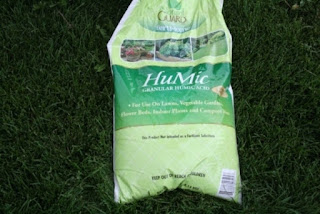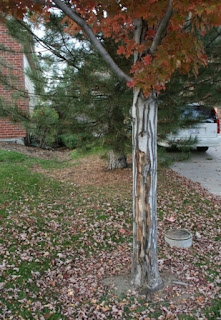Along with your other fall garden chores, it's important to get the trees in your landscape ready for winter. Winterizing trees includes light pruning, adding some organic materials to the soil, watering and in the case of young trees, wrapping the trunk. Pruning this time of year should be confined to damaged branches and suckers. Tree suckers are branches that can emerge from the base of the tree or low on the trunk.
Trees that are under stress will tend to send up more suckers. Prune these branches off now. Small dead branches in the trees canopy can be removed at this time. Using a sharp bypass pruner, cut these small branches near the main trunk. Any major pruning is best done in winter when the tree is dormant.
This is a good time of the year to add organic material to the area under the tree, specifically HuMic. HuMic contains humate, a soil conditioner that improves nutrient uptake, increases microbial activity and offers the benefits of a high-quality compost, all in one package.
Improved nutrient uptake is important for all trees, but especially trees that are suffering from iron chlorosis. If your trees look like this, they are suffering from a lack of iron, also called iron chlorosis. Humate will facilitate more efficient iron uptake in any tree experiencing iron deficiency. The third step in the tree winterizing process is to water each tree thoroughly. A good rule of thumb to remember is your tree needs about 10 gallons of water per inch of trunk diameter.
If your sprinkler system is shut off, you can water by hand using the hose and a simple lawn sprinkler. Where you place the sprinkler depends on whether this is a newly planted tree or an established tree. For newly planted trees, water the root ball area.
For established trees, place the sprinkler half way between the trunk and the drip line. The drip line is the outer edge of the tree’s branches. The key is to water at a slow enough rate that the water soaks in and doesn't run off. Finally, young deciduous trees need to have their trunks wrapped. This is to prevent sunscald. It’s not unusual for winter temperatures to reach 60° Fahrenheit in the daytime. When it gets this warm during the day, the low winter sun heats up the tree bark, especially on the south and southwest sides of the tree. The sun’s warming action breaks the tree's dormancy and the cells on that side of the tree wakeup and become active. When the temperatures fall after sunset, the active cells and tissue die.
This tree exhibits a classic example of sunscald. Prevent sunscald on young trees by applying tree wrap now. Tree wrap is a corrugated paper product, sold in 50' and 150' rolls.
Start at the base of the tree and spiral the wrap upward to the first primary branch. Overlap each turn by one-third. Once you reach the first set of branches, loop the tree wrap over a strong, sturdy branch and tape it, so it will stay in place. A good rule of thumb is to wrap your trees around Halloween and remove the wrap around Easter.








No comments:
Post a Comment